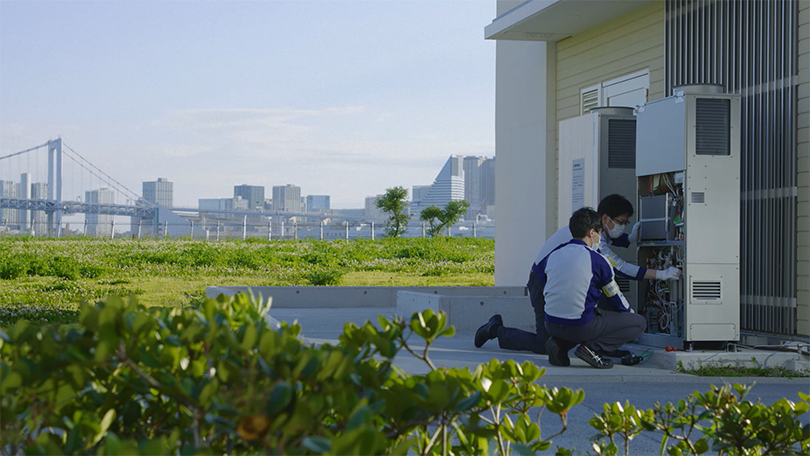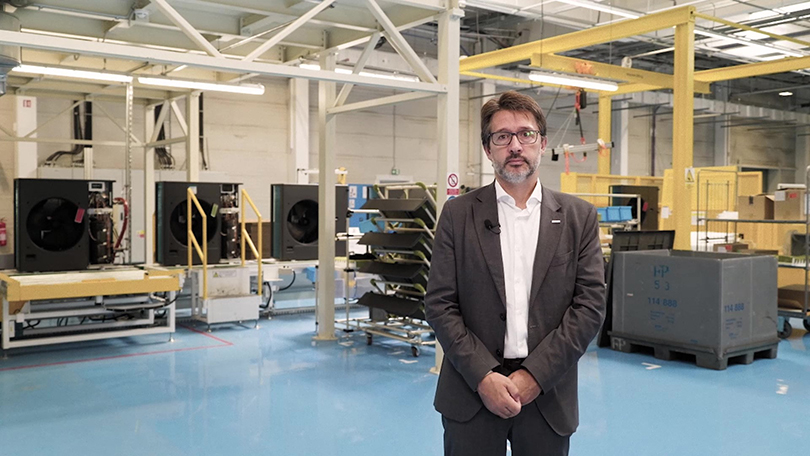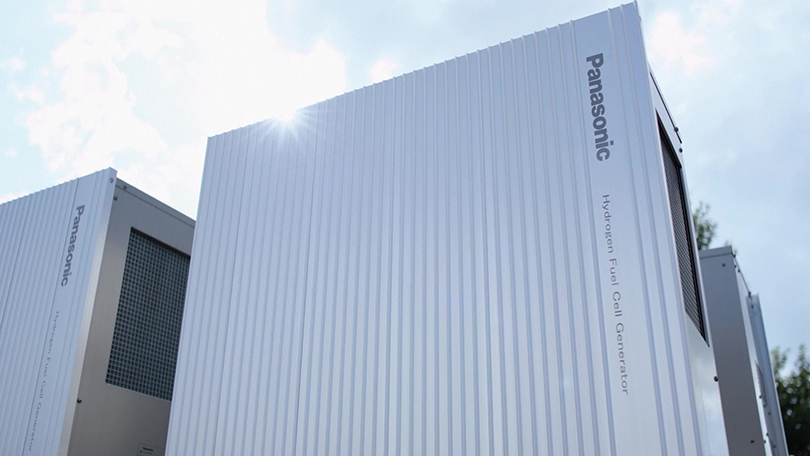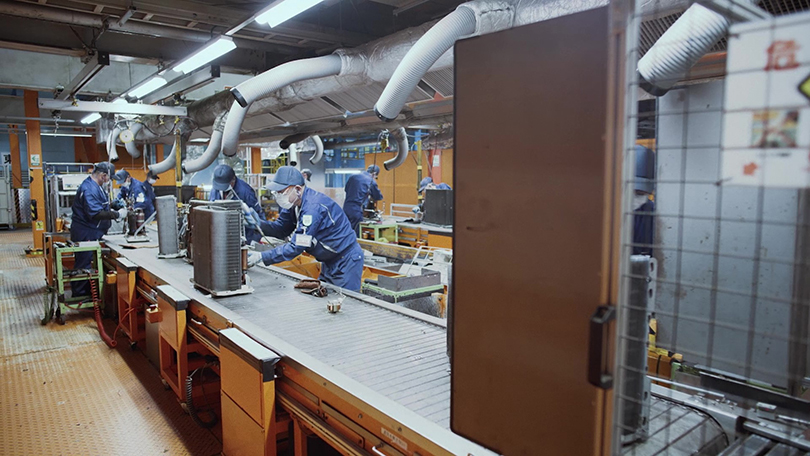With 3-digit million investments in European heat pump production and large-scale hydrogen fuel cell projects, Panasonic demonstrates a strong commitment to greener energy and heating transition in Europe.

Berlin, 29 August 2023 – Panasonic reaffirms its ambition to be a driving force in the decarbonisation of society and Europe at IFA 2023 in Berlin. " Last year at IFA, we made a commitment to accelerate our support for carbon neutrality and the circular economy in Europe. Our goal is to balance individual well-being with global sustainability, and we have been working hard to bring this vision to life and be your best partner to embrace these values", explains Masahiro Shinada, CEO of Panasonic Corporation. To back this up, the company announces, among other things, the massive expansion of heat pump production in Europe, pilot projects aimed at being powered by 100% renewables and being therefore CO₂ -emission-free.
With its GREEN IMPACT Plan, Panasonic has made sustainability the core of its business and has since been working hard to reduce its own CO₂ emissions and to prevent CO₂ emissions in various sectors of society - from factories to homes.
By 2030, the whole Panasonic Group will reduce its CO₂ emissions from Scope 1 & 2 to zero. This includes not only Panasonic's approximately 250 production sites and factories but also all office locations and the energy used for these sites. By 2050, the company plans to have decarbonised its entire value chain (i.e., including Scope 3) including the entire lifetime of its products. At the same time, Panasonic will use existing technologies and business areas as well as develop new ones to avoid CO₂ emissions in society. Panasonic Group companies are currently responsible for around 110 million tonnes of CO₂ emissions per year across the entire value chain (Scope 1, 2 and 3). By 2050, Panasonic aims to reduce and avoid more than 300 million tonnes of CO₂ emissions, which is about 1% per cent of the current total global CO₂ emissions.
31 factories & sites already "Zero-CO₂ Emission Factories".
One of the most important measures to achieve the Group-wide environmental goals is the reduction of CO₂ emissions in the ca. 250 factories owned by Panasonic worldwide. In 2021, Panasonic had only seven such factories worldwide; by the 2025 financial year, it aims to have 37. However, Panasonic should reach this goal sooner thanks to the enormous commitment of all involved: In March 2023, 28 zero-CO₂ emission factories and large scall sites already existed. By the time of the IFA in September 2023, three locations more have already been added, meaning that the interim goal will soon be reached.
Heat pumps from Europe for Europe
To meet the targets of the Paris Climate Agreement, the EU announced in 2019 that it would become the first climate-neutral continent by 2050. An important component of the European Green Deal is the gradual abandonment of fossil fuels for heating in the building sector and the use of effective alternatives such as heat pumps. According to the European Heat Pump Association (EHPA), there are currently more than 20 million heat pumps in operation in Europe. "While the European heat pump market doubled to 3 million heat pump units sold per year between 2019 and 2022, Panasonic's heat pump sales grew fourfold over the same period. And we expect demand to increase tenfold by 2030," says Enrique Vilamitjana Managing Director, Panasonic Heating Ventilation Air-Conditioning Europe.

Accordingly, Panasonic announced this summer that it would massively expand its production facility in Pilsen, Czech Republic, and produce the new Aquarea L series of air-to-water heat pump entirely in Europe in the future. This not only improves the CO2 ratio of production but also ensures shorter time-to-market and improves the ability to respond promptly to market challenges, as manufacturing and customers are in the same region. In addition, Panasonic will use the natural refrigerant R290 in the Aquarea L series, which is much more climate-friendly than other refrigerants thanks to its low Global Warming Potential (GWP) of 3.
"As an important medium-term measure, we have also announced the acquisition of Systemair AC's air-conditioning technology business for 100 million euros to strengthen our commercial heat pump business for apartment buildings and commercial buildings and accelerate our business growth," says Enrique Vilamitjana. Panasonic has massively intensified its commitment to green heating since the introduction of Aquarea heat pumps in Europe 13 years ago (in 2010). "Panasonic has been investing in heat pumps for many years and has continued to develop this important key technology.
This is good news for the European heat pump market and European climate targets," says Dr Jan Rosenow, European Managing Director of the Regulatory Assistance Project (RAP), an international think tank specialising in decarbonising the energy system.
Decarbonisation with hydrogen fuel cell technology

The European Green Deal envisages reducing CO2 emissions by at least 55% by 2030 compared to 1990 levels. In order to achieve these goals, savings must be realised quickly in all areas of the economy and life and the use of fossil fuels must be massively reduced. For companies in particular rising CO2 prices also play an important role: according to a recent study1 by the Potsdam Institute for Climate Impact Research (PIK), the prices for emission certificates could rise to as much as 126 euros/t CO2 in 2030. By 2050, the researchers predict price increases of up to 400 euros/t CO2. In 2020, it was still 25 euros/t CO2. "We believe that fuel cell technology in combination with renewable energy and thus green hydrogen can make an important contribution to the decarbonisation of society. In the residential sector, we have already sold 240,000 fuel cell systems in Japan and Europe, proving their practicality. As there is no green hydrogen grid yet, these systems use natural gas, but still save around 1.4 tonnes of CO2 per year per system due to their efficiency. Now we also want to help companies and public institutions to decarbonise their factories and buildings," explains Teva Laou-Hap, Head of New Business & Technology Development Panasonic Industry Europe.
Last year, Panasonic started to demonstrate with its pilot plant in Kusatsu, Japan, that decentralised, stable and CO2-emission-free production is not a dream of the future, but already possible. It is based on a power supply system that combines and optimises pure hydrogen fuel cells, photovoltaic modules, and lithium-ion batteries via an energy management system. For more than a year, fuel cells have been produced in the factory - with the independently produced electricity from renewable energies of the PV panels or via the fuel cells that draw hydrogen from a local tank, depending on the weather conditions. The pilot plant and the RE100 initiative have attracted a lot of attention in politics and business. This underlines the growing demand for decarbonisation, power stability and cost-efficient building management. In response to the high demand and given the relevance for achieving climate targets, Panasonic announced their latest initiative to develop RE100 pilot projects in Europe in addition. Over the next two years, Panasonic will invest around €130 million to further develop the core technology in Japan and introduce these pilot plants in Europe with plans to expand the “RE100” solution to buildings, commercial facilities, and other areas of daily life. RE100 is a global initiative that brings together many of the world’s influential companies committed to 100 per cent renewable electricity.
Progress in circular business models and the circular economy
The number of natural resources that the earth can provide within one year are exhausted to a greater extent each year – in other words: World Overshoot Day. To put an end to this trend and reverse it as quickly as possible, Panasonic believes that more business models are needed that are oriented towards the principles of the “circular economy”, i.e., the best possible use of materials over the entire product life cycle. On the one hand, Panasonic is therefore pushing for the reduction of resource consumption, the use of sustainable materials and the increased use of recycled plastic. On the other hand, Panasonic is rethinking its own product design philosophy and focusing on longer product life cycles - for example, using modular designs for easier repair or the integration of IoT for predictive fault detection. Other measures such as subscription models or the marketing of used products - possibly with improved components and software updates - are also currently being pushed as part of Panasonic's approach to solutions. With 'TOUGHBOOK Revive', for example, Panasonic Mobile Solutions has already successfully initiated a non-profit circular economy programme that gives business customers the opportunity to donate their discarded Panasonic TOUGHBOOK devices. The devices are refurbished by Panasonic, receive a new product warranty and find a new life with charities and other non-profit organisations.
"We have achieved the resource-based targets set out in the Panasonic GREEN IMPACT PLAN 2021: In the three financial years 2020-2022, more than 42,000 tonnes of recycled plastic material have gone into the manufacture of new products. In the current GREEN IMPACT PLAN 2024 (GIP2024), we are aiming to double this to 90,000 tonnes for the 2023-2025 financial years," explains Markus Reichling, who, as General Manager of Green Transformation, coordinates and drives the Circular Economy issue at Panasonic on a global level.

Panasonic operates its own recycling facilities, which use its know-how to help integrate recyclability even more strongly into Panasonic product design. The aim is to efficiently recover and make available resources in as large quantities as possible. For example, Panasonic can now recycle up to 95% of the materials from its own air conditioning systems. "By prioritising recycling-oriented designs and maximising the use of recycled materials, we are significantly reducing our dependence on virgin resources. Nevertheless, like all other manufacturers, we face the challenge of still significantly increasing the return of discarded products", says Markus Reichling.
In North America, Panasonic Energy is partnering with Redwood Materials Inc., a Nevada-based manufacturer of sustainable battery materials, to supply Panasonic with active cathode materials and copper foil for EV lithium-ion batteries. Redwood's recycled cathode active materials will be used in lithium-ion batteries to be manufactured at a new battery cell factory in De Soto, Kansas, starting in 2025. The recycled copper foil will be used in the production of lithium-ion batteries in Sparks, Nevada, from 2024. "Recycling and a local supply chain are essential to making the most of limited natural resources," said Kazuo Tadanobu, President, and CEO of Panasonic Energy. "By partnering with Redwood, Panasonic Energy can use recycled materials in its high-quality car batteries and contribute to the circular economy. In addition, the partnership allows us to source active cathode materials for North American facilities in North America, which significantly contributes to reducing our CO2 footprint."
On track: GREEN IMPACT PLAN 2024
As a milestone on the way to achieving the 2030 and 2050 targets, the Panasonic Group sets out specific measures to be implemented by then in its GREEN IMPACT PLAN 2024 (FY2025). The aim is to reduce CO₂ emissions, especially from its own operations.
|
|
FY2022 |
FY2025 |
|
|
CO /energy2 |
Own Impact: CO2 savings in our own value chain* |
- |
16.34 Mt** |
|
- Scopes 1&2* : Zero-CO2 Factories |
7 Factories |
37 Factories |
|
|
- Scopes 1&2* : CO₂ savings |
- |
0.26 Mt** |
|
|
- Scope 3* : CO2 savings in the use of our products by customers |
- |
16.08 Mt** |
|
|
Contribution Impact: "Emissions avoided" for society |
23.47 Mt |
38.3 Mt** |
|
|
Resources/ Circular Economy*** |
Factory waste recycling rate |
98,7% |
99% or more |
|
Use of recycled plastic (3-year total)**** |
43.3 Kt |
90 Kt |
|
|
CE-based business models/products |
5 businesses |
13 businesses |
|
* Classification based on the GHG (Green House Gas) Protocol, the international calculation standard
** The size of the CO₂ reduction targets given above is the difference to the FY2021 targets.
*** CE: Circular Economy
**** "3-year sum": FY2020-FY2022 cumulative results / FY2023-FY2025 cumulative targets.
Recommend Pages
News articles relevant to this topic were not found.
-
Panasonic Announces Two New Cameras: Compact Micro Four Thirds LUMIX G97 and Pocket-Sized Travel Zoom LUMIX TZ99

-
PANASONIC OPENS EUROPE’S FIRST PANASONIC HX RENEWABLE ENERGY DEMONSTRATION FACILITY IN CARDIFF

-
Panasonic Announces Firmware Update to Improve the Shooting Experience and Sharing Functionality of LUMIX S5II and S5IIX

-
Panasonic Introduces the World’s Smallest and Lightest* Long Zoom Lens: LUMIX S 28-200mm F4-7.1 MACRO O.I.S. (S-R28200)

-
Panasonic Introduces the World’s Smallest and Lightest* Medium-telephoto Fixed Focal Length Macro Lens: LUMIX S 100mm F2.8 MACRO (S-E100)

-
Panasonic to partner with Amazon Fire TV to deliver new experiential value for smart TVs

-
Understanding The LUMIX Loan Scheme

-
Panasonic accelerates Net Zero ambitions with plans for RE100 demonstration facility in Wales in 2024









